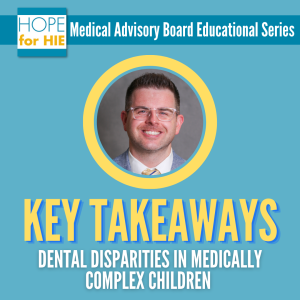
It’s no secret that many people have some aversion to the dentist; those connected to medically complex children are likely even more familiar with the challenge of maintaining oral health and accessing professional care.
Dr. Matt Mara, DDS., a practicing general dentist, assistant professor of general dentistry at Boston University, oral health researcher, Hope for HIE medical advisory board member, and HIE dad, generously offered his time and expertise to discuss dental disparities experienced by HIE children and families, and those in other medically complex and vulnerable populations.
And we have to say, this session was so much more enjoyable than flossing.
Missed our live Q&A? No worries. We took notes, and like any good partner, we are willing to share! Read our key takeaways below.

It’s important to note that many factors contribute to being at higher risk for common dental problems, including a child’s socioeconomic status, race, or even geographical location, as they can all play a role in access to dental care. So, when it comes to looking at oral motor/dental issues faced by those with HIE or other medical complexities, it can be hard to isolate whether or not these conditions are a cause or, rather, a correlation.
Until more research is conducted — and thanks to Dr. Mara, it will be — he says he can safely postulate that there are more oral health complexities for our population, especially when you factor in the additional mobility, physical, and emotional needs that our children face.
With that said, some common dental issues arise in our community, including the most chronic child disease — dental caries (otherwise known as cavities). Lots can contribute to the occurrence of cavities, including the anti-seizure medications some of our children take. While necessary, they can lead to dental tooth delay, gingival overgrowth (or thickening of the gums), and enamel hypoplasia.
To explain this condition, Dr. Mara likens a tooth to an egg, in which its outer “shell” demineralizes or breaks down, letting the acid from sugary foods reach its softer inside or yolk.
Reimagining how providers or even we as parents approach the mouth can help combat (or at least lessen the severity of) these issues: perhaps that is adding or making minor changes to our dental/oral care routine at home, like administering medications with water instead of other sugary drinks, or doing more as a profession to foster better outcomes by empowering and equipping parents with tools and information to help reduce the unnecessary burden of inequitable access to dental care.

As many parents and caregivers in our community can attest, finding a dental provider who can grow, evolve, and adapt to your child’s various or complex needs can be challenging.
One primary barrier may be finding a pediatric dentist in your area. Why attempt to find one? As Dr. Mara explains, pediatric dentists go through an additional two years of training devoted to helping them learn how to provide specialized care and anticipatory guidance for children with various medical complexities; however, this does not make them the only qualified providers to help care for your child’s dental needs! General dentists, especially those willing to have interdisciplinary or collaborative conversations about care, are providers who can act as teammates in this endeavor.
Other barriers include the physical space of the dental office itself: narrow rooms with oversized recliners and clunky X-ray machines don’t exactly scream “accessibility,” especially for those with mobility needs. Plus, the sensory experience of a dental visit is overstimulating: the high-pitched whirring of dental drills combined with the sometimes-not-so-gentle suctioning or vibrations on teeth and gums is enough to averse anyone in that chair. When you add the heightened sensitivity and feelings of vulnerability faced by our children, well, it’s safe to say that it can be a stressful, unenjoyable experience.
As a parent himself, Dr. Mara says it’s an adjustment for any caregiver to reframe what makes a dental appointment “successful.” It’s hard to rewrite the script to one that prioritizes comfort over the completion of care, but in the end, perhaps our motto shouldn’t be “let’s get it done,” but rather, “let’s get it done in a way that is the most thoughtful and comfortable.” For example, don’t hesitate to request smaller goals over more frequent visits.
Providers have their barriers, too: in addition to modifying their working environment to overcome the physical challenges mentioned above, dentistry has historically been siloed among other allied professions. It’s not so much an unwillingness to form a collaborative approach as it is an unintentional result of the specialized nature of dental care, which requires distinct expertise and training separate from general medical practice.
So, what’s the solution? Well, we wish it was a one-size-fits-all situation, but it’s a little more complex than that. For now, let’s not undermine the power that parental and professional advocacy play in creating a more positive, reaffirming dental experience for those who need and definitely deserve it.

As providers or parents, we can all do our part to advocate for our children’s oral motor and dental health. Let’s start big and work our way down, shall we?
Dentistry has made significant progress in the last twenty years regarding recognizing and providing for those with disabilities and differing abilities. Still, like any other profession, traditional training models have yet to find the right recipe, and there’s always more room to grow.
The ideal scenario? Build a training approach focusing on interprofessional collaborative practices and equitable, inclusive care. Let’s embrace the utopian for a minute and imagine a medical building that houses every service for your child, creates action plans based on a shared and comprehensive medical history, and generates long-term goals curated from this deep well of patient history and knowledge.
How many patient-families can say that this care exists? Likely zero, but as Dr. Mara states, that doesn’t mean that we can’t take elements of this approach and embed them into our educational institutions to create practice models that allow for an interdisciplinary collaborative practice among dentistry and all of the other allied professions, whether that’s a pediatrician, neurologist, or other early intervention therapists.
For now, the question is: How do we train and motivate providers to interact appropriately with patients of diverse or vulnerable populations? Again, Dr. Mara says they’re still learning as a profession, but no matter the toolbox they’re working with, every dentist should know how to creatively tailor their work and treatment plan to the patient’s needs. If they are willing to do so, that’s a great marker in telling that they are a provider with whom you can partner to create a comfortable, inclusive, and enjoyable experience for your child.
We’ve said it once, and we’ll say it again and again: you know your child best. This fact, Dr. Mara advises, should act as the foundation of your approach to advocating for your child. If you sense something needs to be corrected, feel free to ask about taking another approach, and don’t be afraid to make a change, even if that means pulling a Goldilocks and switching providers until you find just the right one.
Other advocacy strategies include coming to each dental appointment as prepared as possible. This process looks different for everybody, but it may mean having a list of questions or creating a time and space for advanced conversations or debriefing sessions before or after each appointment.
Also, consider building what Dr. Mara calls a stress reduction protocol. It’s a fancy term, but the concept is simple: what can you and the provider do to alleviate as much anxiety as possible before, during, or after the appointment? Does that mean going at a specific time of day? Does it mean eating before or after the visit? Is there a position, like lap-to-lap –in which the patient faces you with their legs on either side as you help them recline– that can add more comfort to the experience?
Finally, do what you can to try and build a dental health routine at home. There’s a significant emphasis on the “do what you can” part of that sentence, as we know this has the potential to cause feelings of discomfort and add another unnecessary or unfortunate bump in the road. So, start small! Encourage water between meals to stop the acid attack after consuming sugary food or drinks, and see if there are ways to make dental care part of a bonding experience with your child. Read books, play dentist, or even try and replicate the dental environment by interacting with tools, like brushes, but in a non-invasive way, like through painting.
For developmentally appropriate suggestions, recruit the help of Hope for HIE’s child life specialist, Annie Gunning, as she can partner with you in curating a dental hygiene routine at home that is specific to the needs and wants of your child.
You can also take a look at our Oral Motor/Dental Health installment of our Navigating HIE: Peer Perspective series, where Dr. Mara, along with HIE mom Dawn Hamilton, discuss their own insights, experience, and advice when navigating their child’s dental appointments.

Dr. Mara, along with a few of his students from Boston University’s School of Dentistry, are spearheading a research project to identify the WHATS behind dental disparities, specifically for those who have suffered a brain injury and how that has contributed to challenges in accessing dental care and the specific oral motor/dental health issues that have potentially developed as a result.
The goal is to better isolate some of the variables our population faces that may differ from other known challenges to accessing dental care (socioeconomic status, geographical location, race, etc.) Doing so will allow Dr. Mara and other oral health researchers to find real solutions to real problems and turn pain into purpose by building educational tools that can make a difference in reducing some of the dental burdens our population experiences.
Be a part of this research by filling out the survey below:
More information is posted in our closed parent support hub, which you can access below if you are an eligible member:

Connect with families, read inspiring stories, and get helpful resources delivered right to your inbox.